UX Designer Portfolio Tips and Tips
- Transfer
A simple and clear article from Micah Bowers on how best to approach the creation of UX portfolio designer, to get profit.
“How you climb a mountain is more important than reaching the summit.”
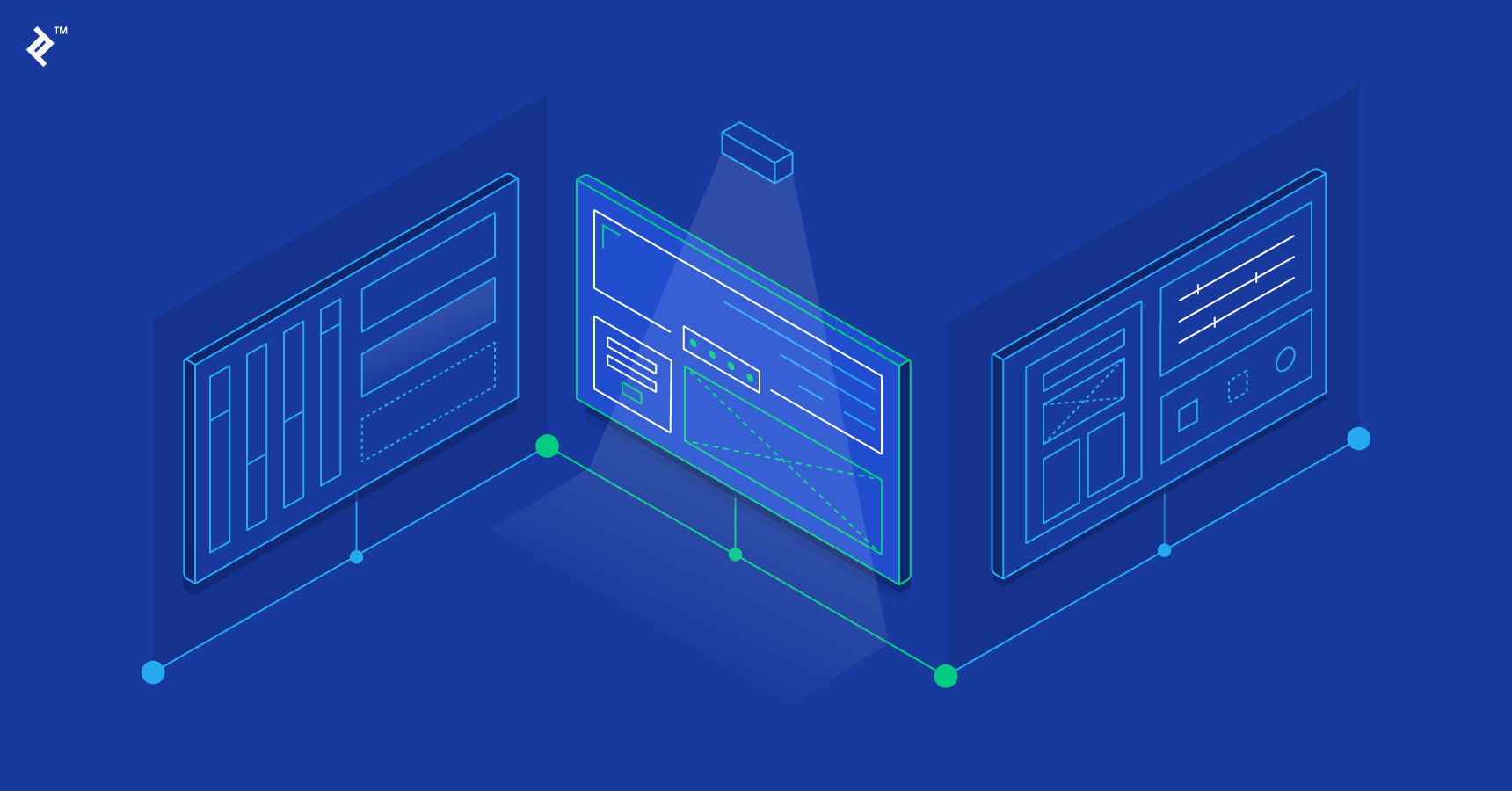
In his memoir, Let My People Go Surfing, Yvonne Chuynard, founder of the global outdoor brand Patagonia, writes:
"How you climb a mountain is more important than the fact of reaching the top."
It is in the world of UX design that methodology is most important, especially in finding customers and career opportunities. One of the best ways for UX developers to demonstrate the methodology and skills of professional problem solving is through a well-designed portfolio site.
Instead of thinking of a portfolio as a demonstration of skills - “This is what I can do” - UX designers should take the opportunity to illustrate the process and create a delightful user experience: “This is how I use design to solve people's problems.”
Just as people want to work in the industries in which they want to work, designers must adapt the portfolio to a specific audience. Why?
In UX Design there are such directions as: interaction designer, UX researcher, information architect and user experience strategist. These roles exist to improve user experience, but they are not essentially different. Each of them makes a unique contribution to the product development process.
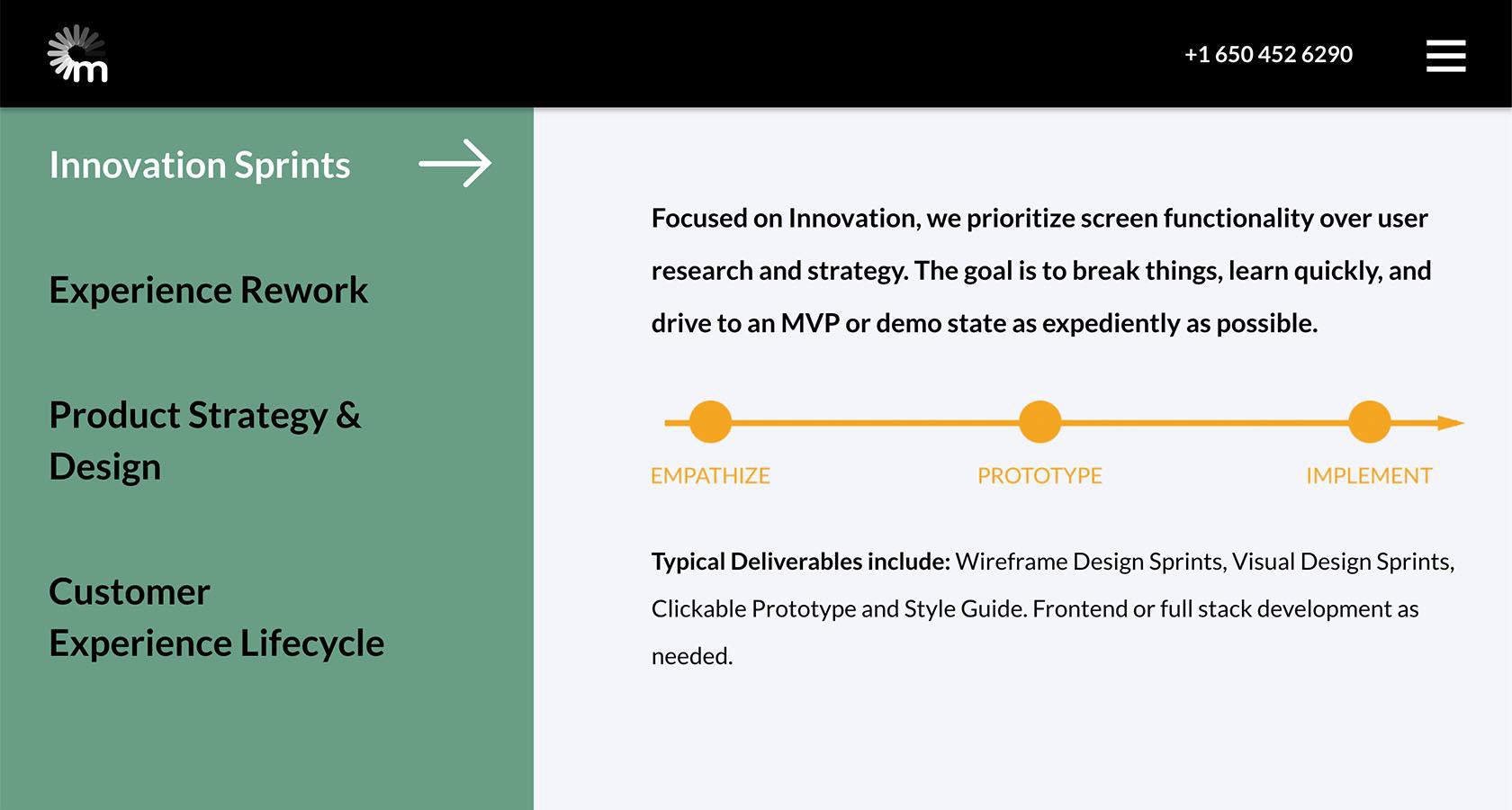
A great way to get inspired to create your portfolio is to view the work of UX design agencies. This example from Momentum Design Lab shows how to combine a complex design process with simple graphics and understandable language.
In this tutorial, we will show UX designers how to create a brilliant portfolio website ...
Let's start.
When it comes to the UX portfolio, the designer should not have an ambiguity regarding the skills they possess, the processes they use, and the types of projects they specialize in, but at the same time the information should not be too much .
Thus, the UX portfolio should not become a repository for ALL past works. Select projects that are specific, fresh and outstanding, and present them as a process with all the UX design steps that were required to achieve the best solution.
For a portfolio to be clear and understandable, planning is necessary. Before you start creating your UX portfolio, there are important questions that need to be answered. Do not skip this step.
The answers can shed light on the content of the portfolio and serve as the organizational structure of the site.
Do not limit future career opportunities to past positions. Take time to evaluate what you are actually doing and how you are doing it. You may be surprised to find out that throughout your career you have been doing the wrong thing. The purpose of this question is to identify patterns of problem solving that you rely on over and over in the UX design process.
This is a rather capacious question, but do not be afraid of what you can find out. Like all voluminous questions, it is better to break it down into smaller questions, so ask yourself:
* Tip. After you have answered these questions, summarize all your answers in one easy-to-read sentence and show it on the Home or About the Author pages of your portfolio.
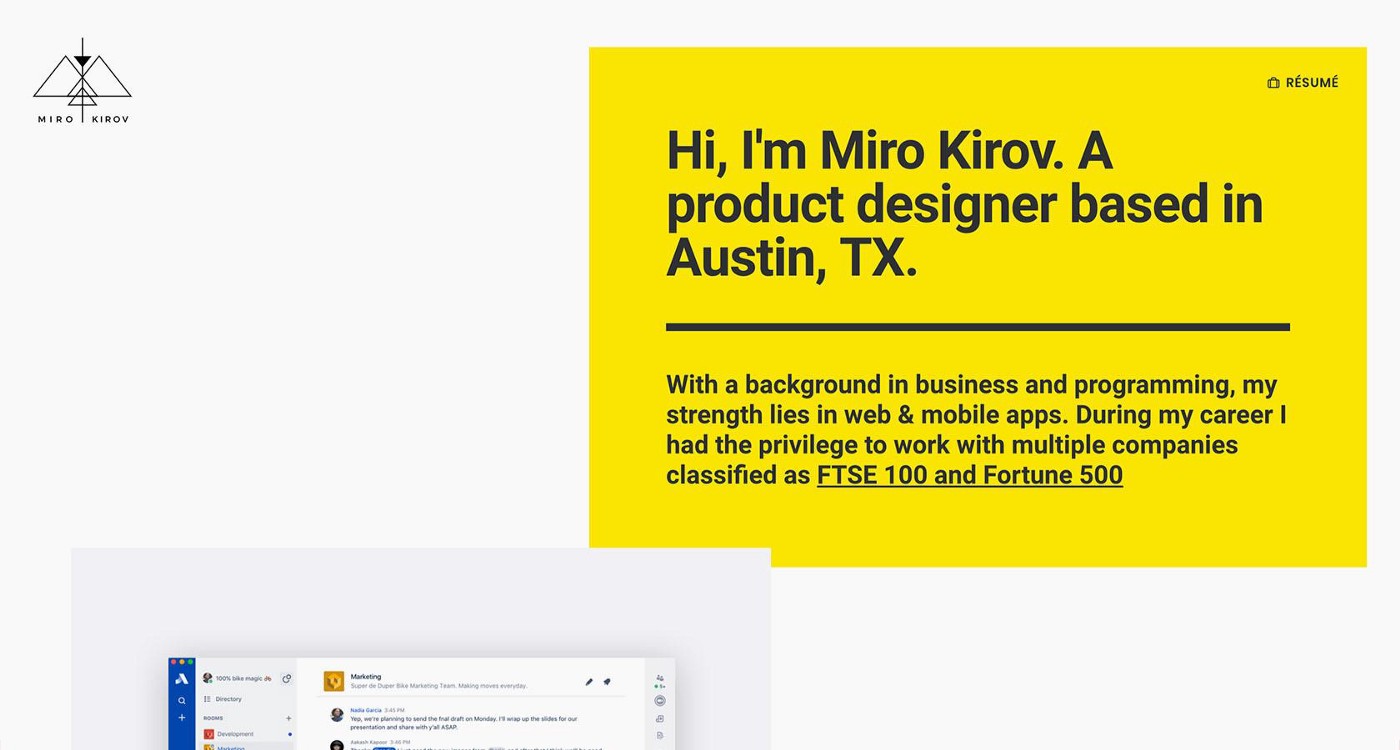
Designer Miro Kirov welcomes visitors to his portfolio with a clear description of his professional experience, strengths and achievements. However, he also hints at the type of clients with whom he seeks to cooperate.
When you understand the internal process of solving problems, it will be time to learn in more detail what you actually do as a UX designer.
Here are some questions to help you get started:
Your answers are important because they show which projects should be included in your portfolio and how to position yourself.
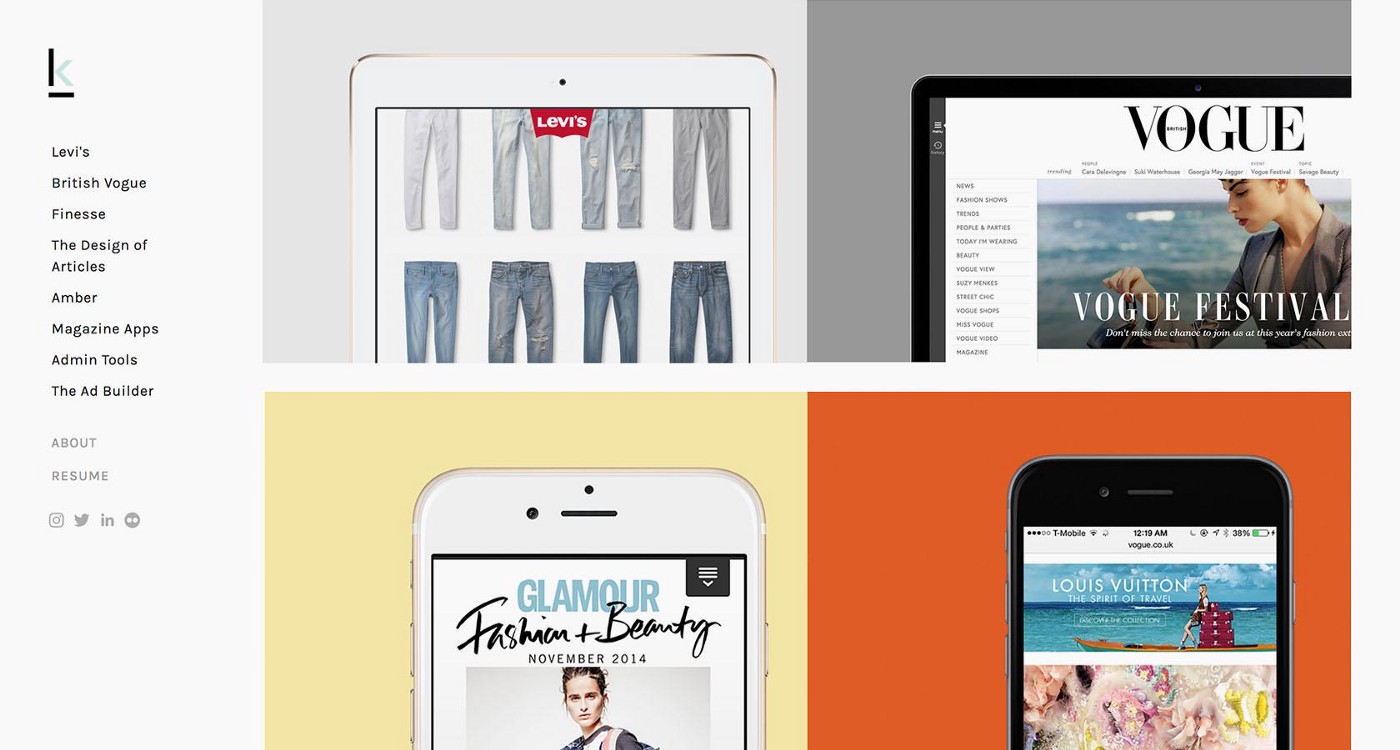
UX / UI designer Kat Windley uses portfolio cover images to showcase his experience with major fashion customers.
For example, if you really want to work as an interaction designer, it would be unwise to create a portfolio around projects and written descriptions that highlight past experience in the niche area of ethnographic research.
Here is a rough example: a long list of “relevant skills” on your website portfolio does not add value to your visitors.

Long lists of design skills and accomplishments are difficult to read, easier to ignore.
The best way to tell about your abilities in UX design is through your projects. This means that you combine the programs and design methods that you use to present visual effects and descriptions of your project.
To get started, take a project you are proud of and ask questions such as:
* Tip: Some UX designers include the “Skills” category for each project in their portfolio. This can be effective, but it can also backfire if you list too many skills or highlight those that do not fit the overall structure of your UX design process.
At the very beginning, young and inexperienced UX designers find it difficult to decide on the type of work they would like to perform, but over time and with several successful projects, it becomes easier to imagine the desired career path. This is an important aspect of the UX portfolio.
The people you work with, the projects you work on, and the industry in which you work should be clearly indicated in the examples and descriptions in your portfolio.
For example, if you have a very specific goal of becoming a user-researcher of digital products that influence the world of university sports, your portfolio should reflect this.
To get an idea of how and for whom you would like to use your UX design skills, ask yourself questions:
This is not an exhaustive list, it's good to start at least with this. If you are an experienced developer of solutions for UX, you will be in great demand, but it also means that people will be ready to hire you, even if you don’t really fit them. Ultimately, you must periodically incorporate an internal censor and plan your UX career that is consistent with your ambitions.
Each pixel of your portfolio site is an opportunity to create a delightful user interface. From the visualization of projects to the information architecture of the site, each design element is a chance to say: “I am the top designer of UX”
Bottom line: treat your portfolio as a professional project, and incorporate these practical design tips into your site development.
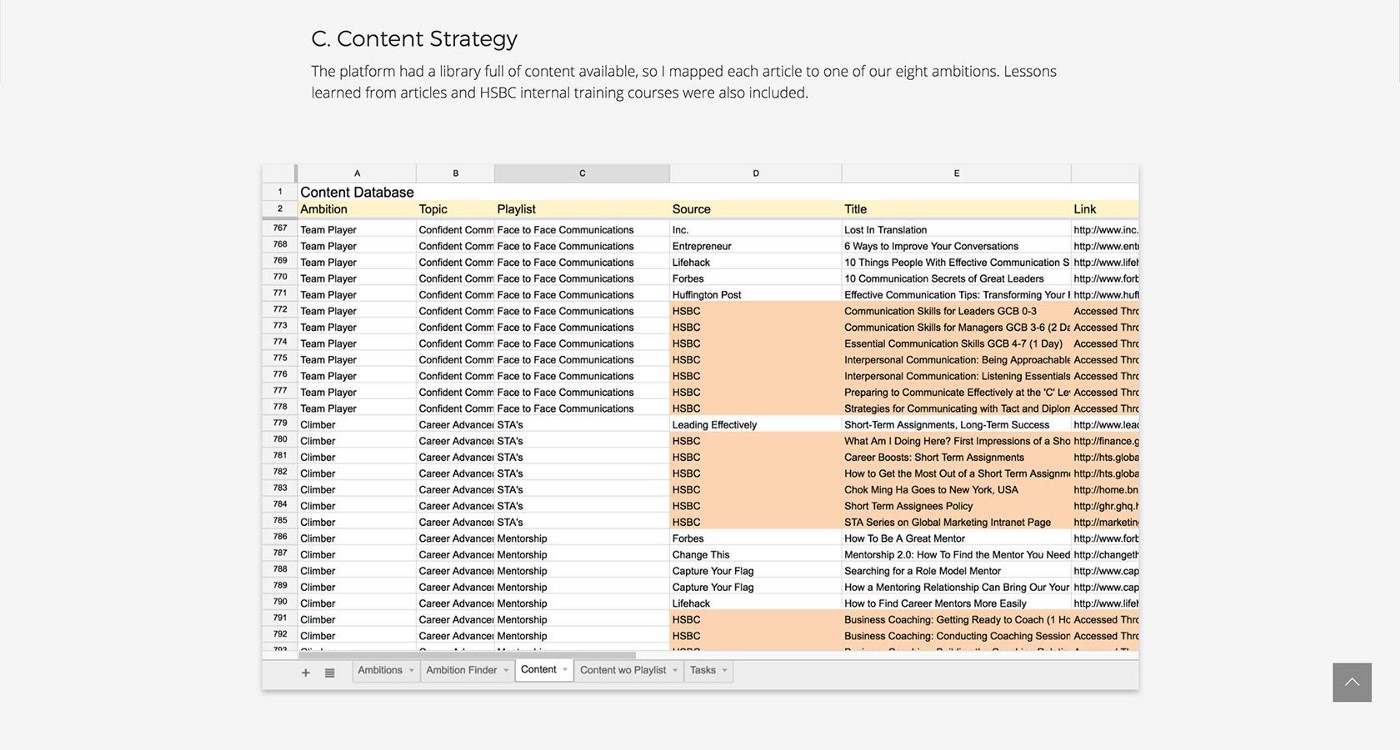
Experienced UX designers, such as Jeffrey Davis , know the value of displaying the non-glossy artifacts of their design process (for example, this content strategy table).

Even UX design agencies, such as Cyber Duck, exchange conceptual sketches and interfaces with low accuracy as a way to demonstrate problem solving.
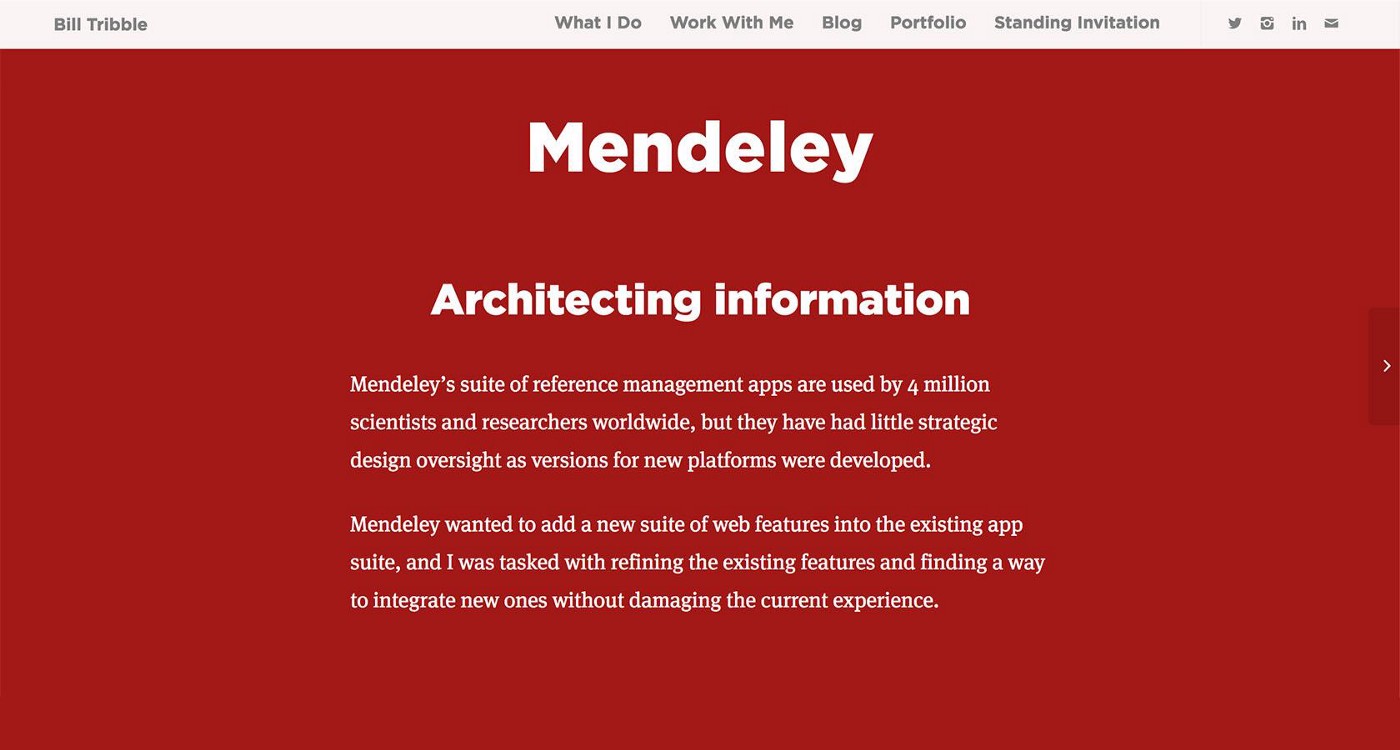
Bill Tribbla's project briefly describes the UX design problem and shows its role in the solution.
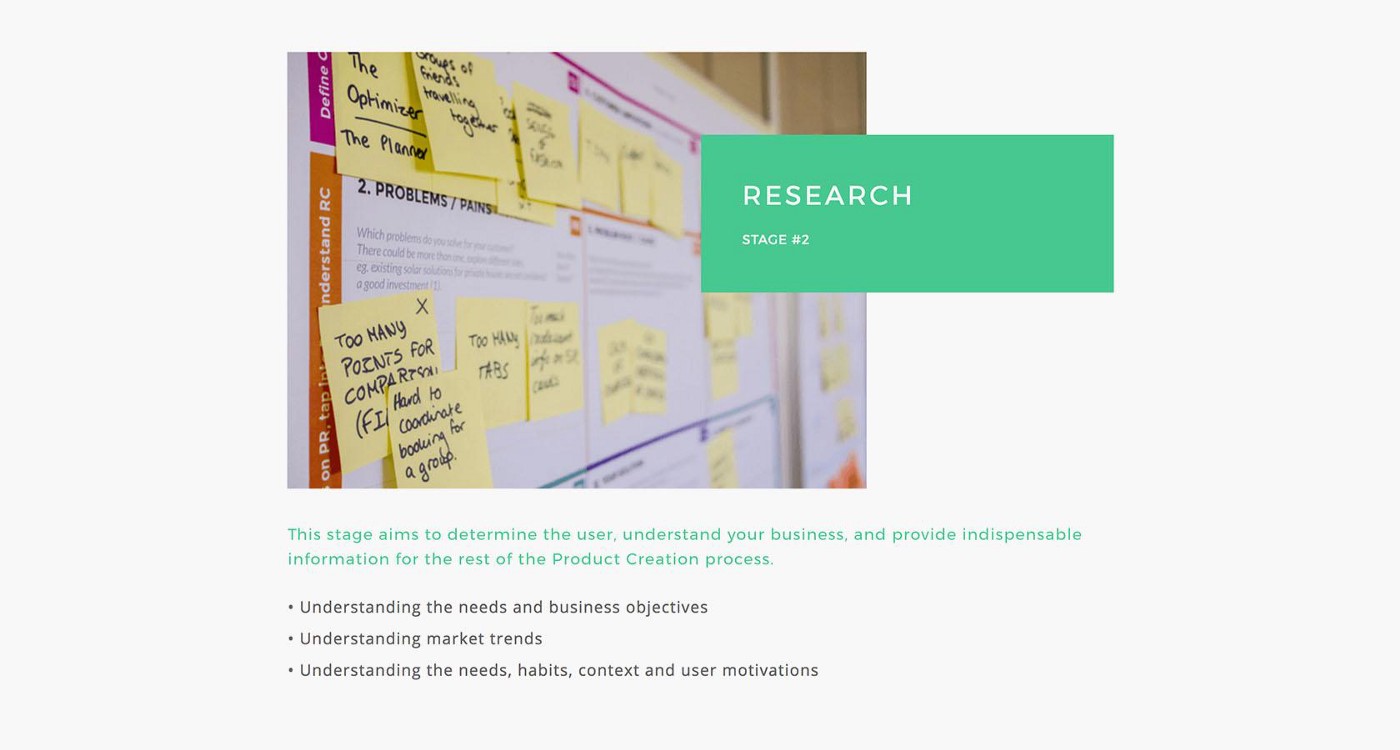
UX design research can be tricky, but designer Maria Corino uses an understandable language to clarify her research efforts.
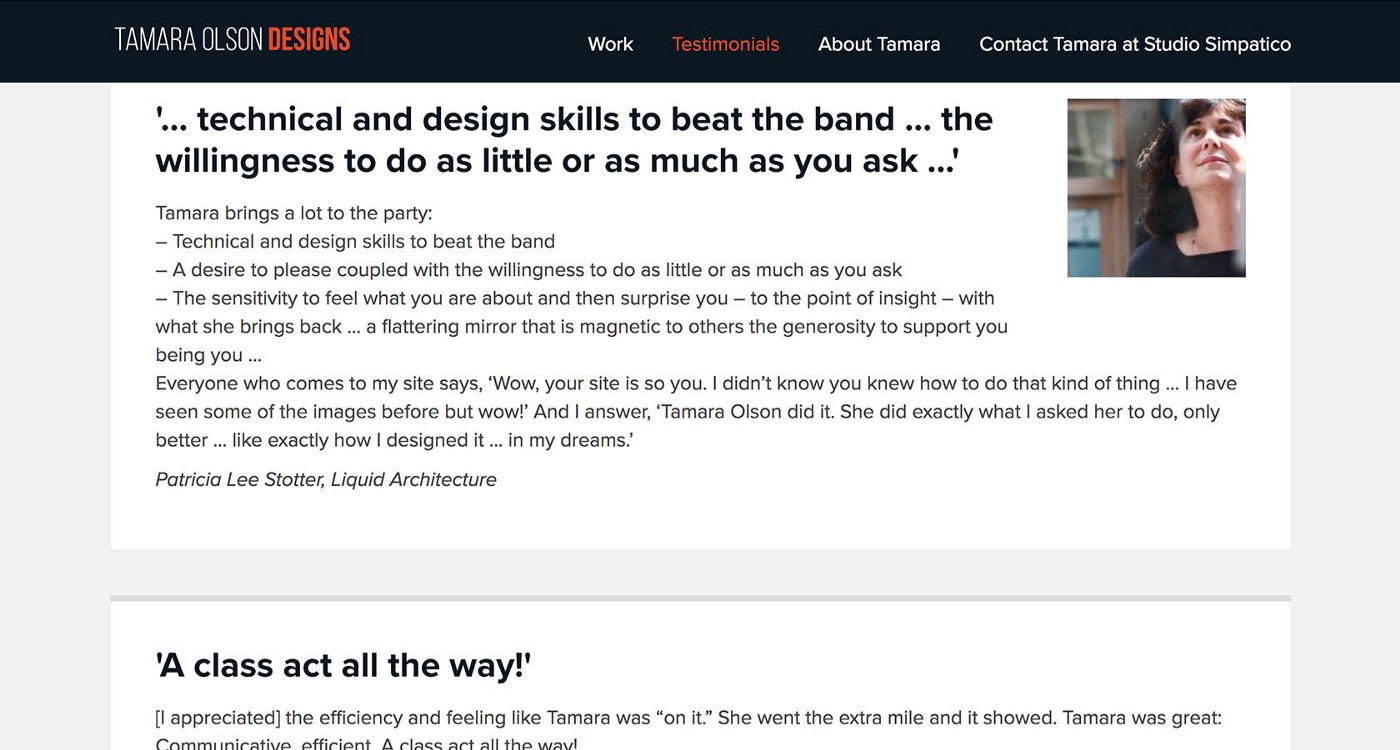
Designer UX Tamara Olson relies on a bold headline to highlight key phrases from customer reviews that speak about her design skills and positive customer relationships.
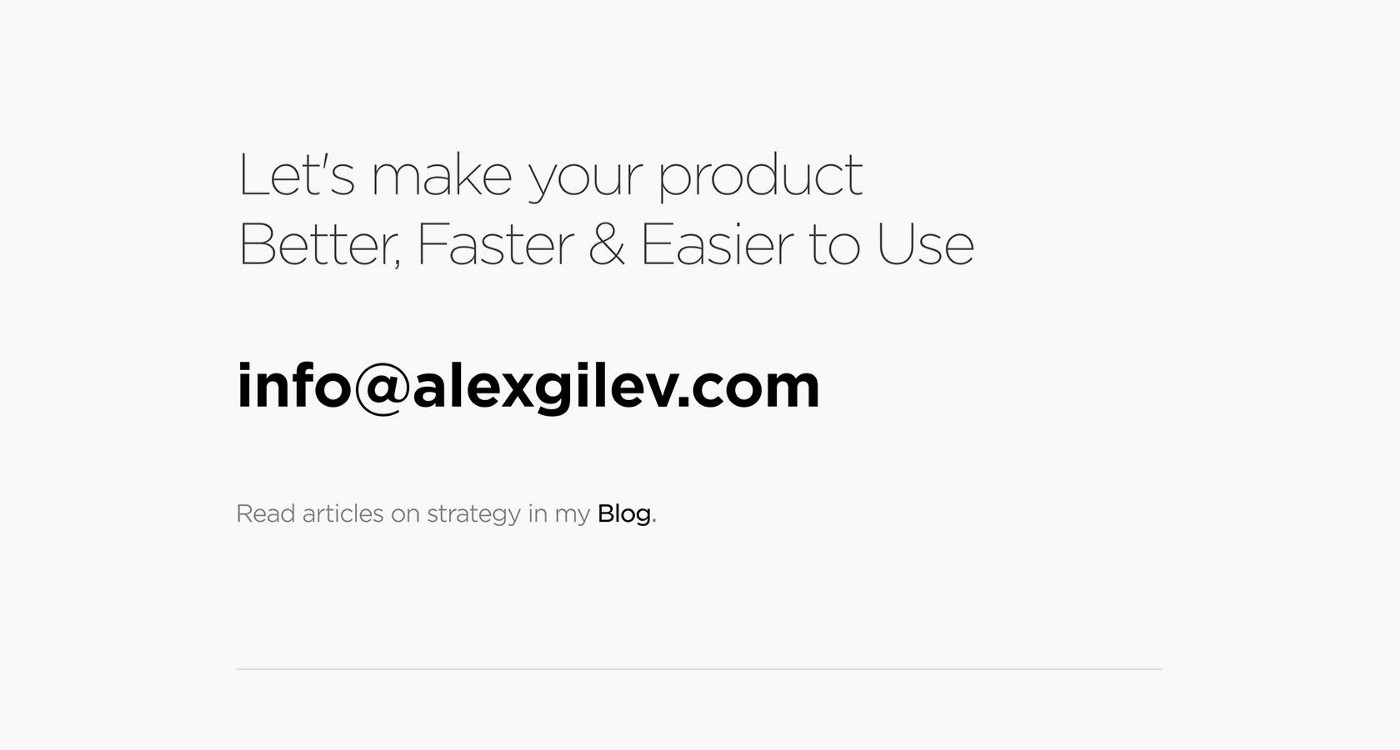
Designer UX Alex Gilev instead of the button "Contact me", seduces visitors with the promise: "Work with me and your product will improve."
If you have not learned anything from this guide, remember these five basic truths:
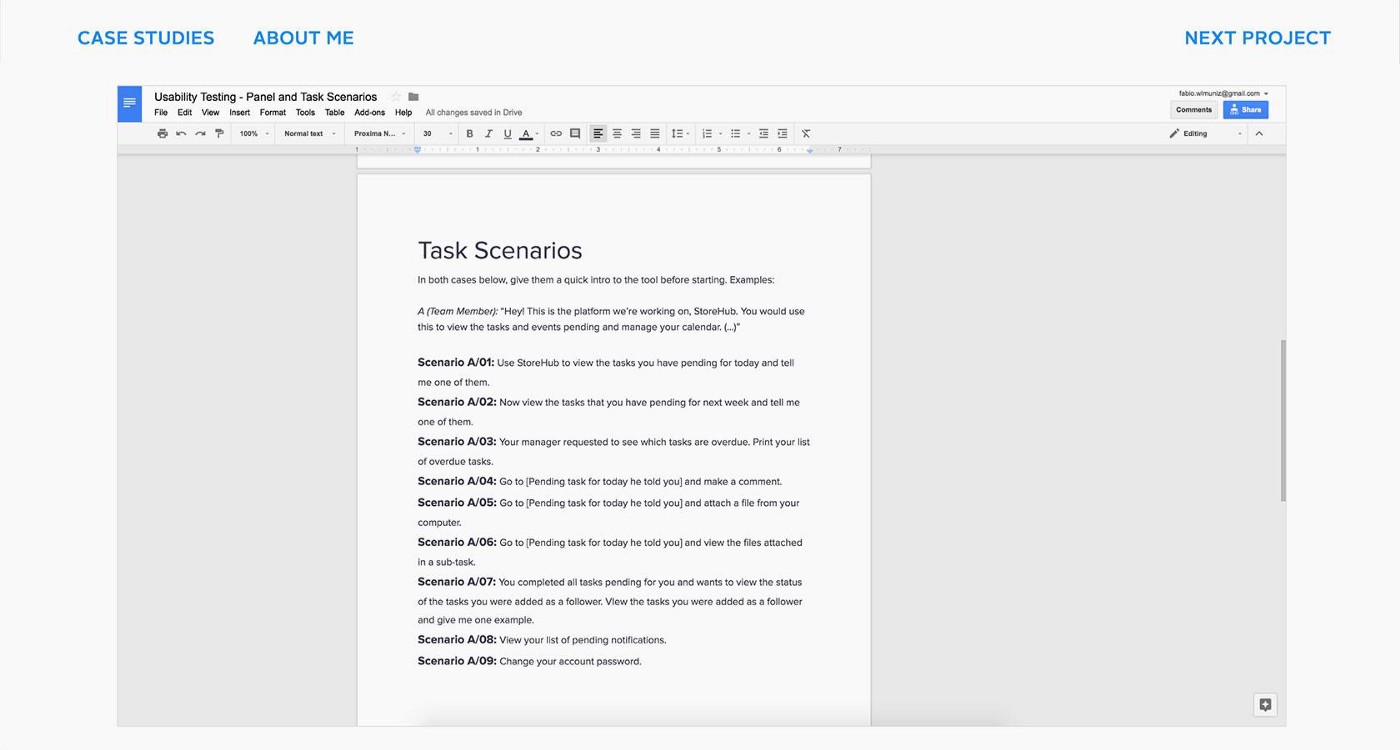
UX designer Fabio Muniz shares a design artifact created in Google Docs. Remember that showing off product images is normal, but they have nothing to do with the designer process.
Make no mistake - developing a UX portfolio site is a significant job that requires careful thought and execution, but when the process stays in the foreground, this is one of the best ways for designers to gain access to careers and customers that they have always dreamed of.
Originally published on www.toptal.com .
“How you climb a mountain is more important than reaching the summit.”

In his memoir, Let My People Go Surfing, Yvonne Chuynard, founder of the global outdoor brand Patagonia, writes:
"How you climb a mountain is more important than the fact of reaching the top."
It is in the world of UX design that methodology is most important, especially in finding customers and career opportunities. One of the best ways for UX developers to demonstrate the methodology and skills of professional problem solving is through a well-designed portfolio site.
Instead of thinking of a portfolio as a demonstration of skills - “This is what I can do” - UX designers should take the opportunity to illustrate the process and create a delightful user experience: “This is how I use design to solve people's problems.”
Just as people want to work in the industries in which they want to work, designers must adapt the portfolio to a specific audience. Why?
In UX Design there are such directions as: interaction designer, UX researcher, information architect and user experience strategist. These roles exist to improve user experience, but they are not essentially different. Each of them makes a unique contribution to the product development process.

A great way to get inspired to create your portfolio is to view the work of UX design agencies. This example from Momentum Design Lab shows how to combine a complex design process with simple graphics and understandable language.
In this tutorial, we will show UX designers how to create a brilliant portfolio website ...
- Consideration of key questions about the process;
- We share practical tips and portfolio design resources; and
- Vivid examples of UX portfolio.
Let's start.
Portfolio questions that every UX designer must answer
When it comes to the UX portfolio, the designer should not have an ambiguity regarding the skills they possess, the processes they use, and the types of projects they specialize in, but at the same time the information should not be too much .
Thus, the UX portfolio should not become a repository for ALL past works. Select projects that are specific, fresh and outstanding, and present them as a process with all the UX design steps that were required to achieve the best solution.
For a portfolio to be clear and understandable, planning is necessary. Before you start creating your UX portfolio, there are important questions that need to be answered. Do not skip this step.
The answers can shed light on the content of the portfolio and serve as the organizational structure of the site.
What type of UX designer am I?
Do not limit future career opportunities to past positions. Take time to evaluate what you are actually doing and how you are doing it. You may be surprised to find out that throughout your career you have been doing the wrong thing. The purpose of this question is to identify patterns of problem solving that you rely on over and over in the UX design process.
This is a rather capacious question, but do not be afraid of what you can find out. Like all voluminous questions, it is better to break it down into smaller questions, so ask yourself:
- Is there something in common that goes through all kinds of UX design problems that I usually solve?
- What are the repetitive steps of my UX design process?
- What methods do I use to conduct research, and what do I do with the results?
- Are there approaches to solving problems that I value above others?
- How did I get to this point in my UX design career and what is my real experience?
* Tip. After you have answered these questions, summarize all your answers in one easy-to-read sentence and show it on the Home or About the Author pages of your portfolio.

Designer Miro Kirov welcomes visitors to his portfolio with a clear description of his professional experience, strengths and achievements. However, he also hints at the type of clients with whom he seeks to cooperate.
What I do in the field of UX design
When you understand the internal process of solving problems, it will be time to learn in more detail what you actually do as a UX designer.
Here are some questions to help you get started:
- Am I a UX designer or researcher?
- Am I a UX generalist? Can I easily switch between research and UX design?
- I'm an expert? Is there a specific UX research or design task that I do well and would like to improve?
- Can my skills cover user interface design and visual design?
- Do I have the ability, experience and desire to manage a team of UX professionals?
Your answers are important because they show which projects should be included in your portfolio and how to position yourself.

UX / UI designer Kat Windley uses portfolio cover images to showcase his experience with major fashion customers.
For example, if you really want to work as an interaction designer, it would be unwise to create a portfolio around projects and written descriptions that highlight past experience in the niche area of ethnographic research.
Here is a rough example: a long list of “relevant skills” on your website portfolio does not add value to your visitors.

Long lists of design skills and accomplishments are difficult to read, easier to ignore.
The best way to tell about your abilities in UX design is through your projects. This means that you combine the programs and design methods that you use to present visual effects and descriptions of your project.
To get started, take a project you are proud of and ask questions such as:
- What did I add to this project at every stage of the UX design process?
- What tools and techniques have I used for this?
- Did I create or help implement a strategy that had a great impact on the final product?
- Have I been involved in early negotiations with a client or the development of a project proposal?
- Were there any serious obstacles that required me to complete tasks outside of my normal competence?
- Do not sell yourself cheaply. If you carefully study your participation in the project, you will most likely find that you have done much more than just “do research” or “use software”.
* Tip: Some UX designers include the “Skills” category for each project in their portfolio. This can be effective, but it can also backfire if you list too many skills or highlight those that do not fit the overall structure of your UX design process.
Who needs my UX design skills?
At the very beginning, young and inexperienced UX designers find it difficult to decide on the type of work they would like to perform, but over time and with several successful projects, it becomes easier to imagine the desired career path. This is an important aspect of the UX portfolio.
The people you work with, the projects you work on, and the industry in which you work should be clearly indicated in the examples and descriptions in your portfolio.
For example, if you have a very specific goal of becoming a user-researcher of digital products that influence the world of university sports, your portfolio should reflect this.
To get an idea of how and for whom you would like to use your UX design skills, ask yourself questions:
- What are the two best industries I would like to work in?
- Do I have projects or past experience that will help me get a job in my favorite industry?
- What is my working pace? Does working overtime suit me?
- Do I want to be a freelancer? Work with startups? Or do you want to be a careerist?
- There is something I want my work to influence?
- How much do I want to receive?
- Where do I want to live? I want to work remotely?
This is not an exhaustive list, it's good to start at least with this. If you are an experienced developer of solutions for UX, you will be in great demand, but it also means that people will be ready to hire you, even if you don’t really fit them. Ultimately, you must periodically incorporate an internal censor and plan your UX career that is consistent with your ambitions.
Tell and Show - Practical Design Tips for UX Portfolios
Each pixel of your portfolio site is an opportunity to create a delightful user interface. From the visualization of projects to the information architecture of the site, each design element is a chance to say: “I am the top designer of UX”
Bottom line: treat your portfolio as a professional project, and incorporate these practical design tips into your site development.
Visual simplicity should be central to the design process.
- Present the artifacts of your UX design process in a clean, uniform, and consistent fashion. We are talking about sketches, frames, maps of user travel, prototypes and much more.
- Enabling features such as complex animations or unconventional page layouts can distract visitors from the real reason they came to your site — to see your work.
- Of course, you can show glossy pictures of the final product, but this is only a small part of the story. HR managers and potential customers want to quickly see and understand your process, and the glossy interface does not fall into the basis of your problem-solving efforts.

Experienced UX designers, such as Jeffrey Davis , know the value of displaying the non-glossy artifacts of their design process (for example, this content strategy table).

Even UX design agencies, such as Cyber Duck, exchange conceptual sketches and interfaces with low accuracy as a way to demonstrate problem solving.
- Provide a summary description of each project in your portfolio.
- Briefly identify the problem and show how the various solutions were investigated.
- The result of the project is not a list of what you have done, but a way to show what positive results you have achieved.

Bill Tribbla's project briefly describes the UX design problem and shows its role in the solution.
Show your expertise by explaining the process without jargon
- No one comes to your UX portfolio site to be impressed with your extensive technical jargon knowledge.
- Use explanations that are accessible and professional, and avoid excessive narcissism and insider humor.
- Explain in simple language that will be understood as technology changes.
- Simplicity is comprehensible, so write in a simple language that can be easily understood by non-specialists. After all, the hiring person may not be familiar with the complex terminology of UX.

UX design research can be tricky, but designer Maria Corino uses an understandable language to clarify her research efforts.
Demonstrate your ability to collaborate with others.
- This ability should not be intentional, but should show examples where you have worked well with other design and development professionals.
- If you have experience with C-Suite, highlight it.
- If you managed a product development team or a group of remote employees, do not forget to specify this.
Carefully check your work and drop everything that you think is not ideal.
- Checking before publishing is one of the most difficult tasks for creative professionals, but pay attention to the fact that people visit your portfolio, not to make a thorough analysis of every project you have ever published.
- In addition, your work 3-4 years ago is likely to be very different from the projects you have been working on for the past year and a half.
- Show your best work, and make sure that there is nothing that contradicts your normal UX design process.
Build trust based on customer testimonials
- Designers often create close working relationships with project participants. Include one or two feedback sentences from a project member and this will be a great way to instill confidence in people who want to hire you in the future.
- Make sure the testimonials you use are related to the type of UX customers you want to attract.

Designer UX Tamara Olson relies on a bold headline to highlight key phrases from customer reviews that speak about her design skills and positive customer relationships.
- For your potential clients or HR hiring managers it will be very useful to get acquainted with your projects on your own, so feel free to insert links to live examples of your work.
- But do not rely only on links. Each project in your portfolio needs context and explanation of your participation.
- Warning: check your links from time to time to ensure that your work is still relevant. Clients sometimes have a habit of making adjustments during the operation of the site, which may in turn discredit you as a specialist.
- It’s easy to lose sight of, but it’s important (especially for freelancers) for site visitors to be in touch.
- At the end of the project, you can add the phrase - like it, write to me.
- Provide one or two reliable ways to contact you.

Designer UX Alex Gilev instead of the button "Contact me", seduces visitors with the promise: "Work with me and your product will improve."
Remember the 5 core components of an expert UX portfolio
If you have not learned anything from this guide, remember these five basic truths:
- The process is paramount, and the UX designer's portfolio must clearly define which way the designer goes from problem to solution.
- A UX designer portfolio is more than a demonstration of skills; it is an opportunity to create a pleasant user interface and demonstrate the mastery of the UX design process.
- Simple project descriptions and visual effects are more effective than technical jargon and images for pictures.
- Each project in the UX designer's portfolio should reflect the role played in the project and the result of the work.
- Designers must adapt their UX portfolios to a specific audience.

UX designer Fabio Muniz shares a design artifact created in Google Docs. Remember that showing off product images is normal, but they have nothing to do with the designer process.
Make no mistake - developing a UX portfolio site is a significant job that requires careful thought and execution, but when the process stays in the foreground, this is one of the best ways for designers to gain access to careers and customers that they have always dreamed of.
Originally published on www.toptal.com .
